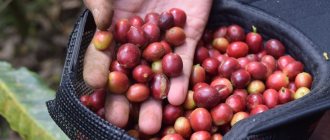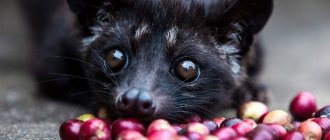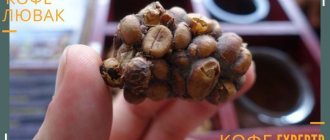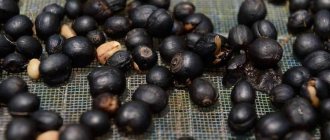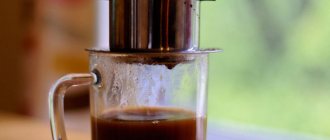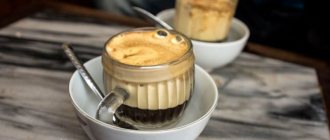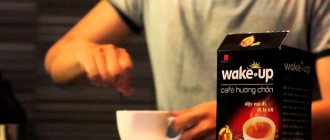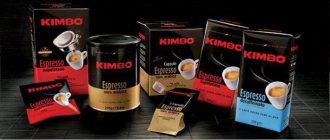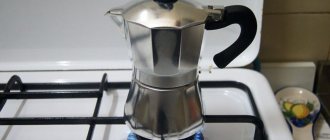Fans of an invigorating drink know the difference between Arabica and Robusta, espresso and cappuccino, but not everyone has had the chance to try coffee made from animal droppings. The specific production method and unusual taste ensured the demand for coffee beans in many countries around the world. Due to the incredibly high price, the exclusive product is not widely used and remains available to a few.
What is Luwak coffee?
The elite variety of coffee Luwak received its name from an animal native to South Asia, thanks to which the origin of the product became possible. A representative of the civet family is called luwak, common musang, civet or palm marten. The gray omnivore with black stripes and spots is nocturnal and loves coffee berries.
According to legend, one peasant from the island of Sumatra ate all the fruits from the coffee trees. Shocked by what happened, he noticed that the animals left behind feces with whole coffee beans. He had no choice but to extract them from the excrement and use them for his own consumption.
According to other sources, the history of this variety began in the 18th century, when the Dutch founded coffee plantations on the islands of Sumatra and Java. In 1830, a decree was issued prohibiting local residents from consuming the fruit. To avoid paying huge fines, peasants began extracting coffee from civet feces. The extracted beans were washed, fried, crushed and a delicious aromatic drink was brewed.
Rumors about this miracle product quickly reached the Dutch. They also liked the taste of fermented grains, but the owners of the plantations for a long time did not dare to publish the unusual production technology. Kopi Luwak entered the world market only after World War II.
The secret of bean processing technology lies in the digestive process that occurs in the body of palm martens. Gastric juice dissolves the outer shell of the grains, and under the influence of special microflora, multi-stage fermentation occurs in the intestines. The musk secreted by the civet's stomach gives the product a special taste and aroma, and removing the shell and breaking down the oils reduces the bitterness and makes the taste less harsh.
The main consumers of Kopi Luwak are Japan, Hong Kong, and the UK.
From marten to monkey and elephant excrement
Martens are omnivores and feed on a variety of fruits and insects. It goes without saying that coffee berries should not be the main part of their diet, since caffeine affects animals in the same way it affects humans.
This method of producing coffee is not only idiotic, but is a clear example of animal cruelty.
Recently, similar coffee has appeared in South America and the rest of Asia. The most notorious are coffee made from monkey droppings and Black Ivory coffee, which passed through the digestive system of an elephant.
How it is produced
Palm martens do some of the work for the peasants. In the stomachs of animals, selected ripe berries are freed from pulp and fermented. Undigested grains leave the body of the musang naturally along with excrement.
Farmers who pass on their business from generation to generation carry out further processing:
- the droppings are collected, laid out on flat horizontal surfaces until completely dry, and stirred periodically;
- Selected beans are manually separated from feces;
- washed in several waters, dried in the sun;
- fried in different ways.
The raw materials are obtained from wild musangs fed on plantations or kept in captivity on animal farms. Civets are able to eat up to 1 kg of large red berries with a sweetish taste. The stomach cannot cope with such a volume of food and some of the beans come out undigested.
Where are the coffee plantations in Bali?
If in Europe the cost of a kilogram of kopi luwak reaches a thousand dollars, then on the island of Bali it is sold from 300 dollars (cheaper luwak coffee can only be found in Vietnam). This is because there are numerous coffee plantations in Bali, which any tourist can take excursions to.
The Balinese greet each guest with a cup of rice and a mug of the aromatic coffee drink for which Indonesia is famous. Coffee trees have been cultivated here for more than three centuries in a row, collecting about 700 thousand tons of beans annually, the lion's share of which is exported. The rest is sold to numerous tourists.
Plantations in Bali are located in the northern and central parts of the island. Visitors can see with their own eyes the coffee production process, participate in its collection and preparation of the drink. There are tourist farms where guests are invited, and there are closed ones, mostly located in the Kintamani mountains, and the produced product is sent directly to partner companies with which a contract has been concluded.
Coffee farms are located on the slopes of ravines and occupy relatively small areas of up to 8 acres. Trees, spices and exotic fruits are planted there. Arabica and Robusta are mainly grown here.
What does Arabica (Arabian tree) look like:
- plant 3-5 meters high;
- elongated and large fruits;
- grows on mountain and volcanic slopes at an altitude of up to 2000 meters at a temperature of 15-25 degrees and a humidity of 1500-2000 millimeters;
- fruits ripen in 8-9 months;
- low caffeine content;
- slight sourness in taste.
What is robusta (canephora):
- reaches a height of 15 meters;
- round and small fruits;
- grows at an altitude of 200-900 meters at temperatures up to 30 degrees and 3000 millimeters and above precipitation;
- fruits ripen in 10-11 months;
- strongly expressed shade of strength;
- high caffeine content.
Arabica is more expensive than robusta, so the latter predominates on plantations. The volume of Arabica cultivation is smaller, but it can often be found in signature Balinese blends.
Coffee plantations are like forests. Entire families work for them, hiding secrets from strangers and passing them on from generation to generation.
The best grains selected for planting are germinated in warm soil and then transplanted to windless places with moderate light. Sometimes seedlings are planted under large trees to protect them from direct sunlight and rain.
Conditions for obtaining a good harvest:
- Soft and loose soil. The ideal place is at the foot of the volcano.
- Highlands, because coffee does not like the plains.
- High humidity and a lot of precipitation.
The crops are fertilized with pig manure; pigs are kept on farms for these purposes. The pens are located on hills, with special grooves running from them to the roots of the trees so that the fertilizer flows directly to the sites.
Coffee trees bloom in the third year after planting and bear fruit in the fourth. At 5-7 years, the fruits can be harvested; they reach the required maturity.
The plant produces a good harvest up to 18 years, after which it begins to age. But there are specimens that bear fruit for half a century.
Indonesians offer to try medium and high quality Arabica, a mixture of Robusta and Arabica, three-in-one coffee (finely ground with cream and sugar) and coffee made from excrement - Luwak.
What is the reason for the high price?
The high price tag for Luwak is explained not only by the complexity of processing. The formation of cost is influenced by the following factors:
- An adult civet cat living on a farm defecates feces containing no more than 50 g of beans. Animals choose only ripe berries from the offered ones, the rest are disposed of.
- To search for wild musang droppings, we need trained people who receive decent wages for their work.
- Kopi Luwak is made from March to September, when the stomach juice of palm martens produces a substance called civet, which changes the taste of the grains. The rest of the time production is idle.
- Musangs do not breed on farms. In September they are released into the wild, and in the spring of next year new individuals are caught in the tropical forests. The animals are smoked out of holes or hollows where they hide during the daytime.
Keeping civets is expensive for nursery owners. We have to pay wages to workers serving animals and coffee plantations. Since the musangs' diet consists not only of coffee berries, they are bought other products - chicken, eggs, fruits, and vegetables. Civets are under constant veterinary supervision, which significantly increases the cost of the final product.
The average retail price of Luwak coffee is $400–600, and the wholesale price is $100. Coffee beans fermented by wild animals are not commercially available. They quickly sell out at auctions at prices of 4–6 thousand dollars per kilogram.
Luwak coffee tasting
After the tour we were invited to a table,
to a tasting ceremony, where they offered to taste several types of tea, as well as regular coffee.
We leisurely sipped tea, enjoying the views of the rice terraces.
But we were also offered to try kopi luwak, but for a fee - a cup of exclusive food costs 50,000 rupees ($5).
We tried it later, at the Food Festival in Ubud (which we'll talk about later) - if you drink it with as much sugar as the Indonesians like, you can't tell the difference.
Without sugar, the taste of Luwak coffee is slightly different - it is softer and less tart, but in our opinion, the price for it is increased more for the name than for the taste, although this is only our personal opinion, and we, again, are not coffee connoisseurs
